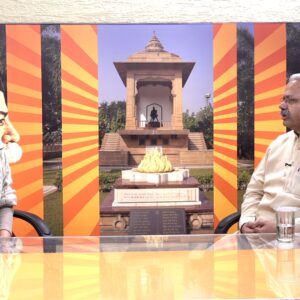~ By Shakti Sinha
To paraphrase, John Kennedy famously said that success has many fathers but failure was an orphan. The claim of the opposition Congress party is that it was due to their pressure that the Finance Minister Arun Jaitley made revival of agriculture and the rural economy. The focus of his budget is proof that this non-theatrical and practical approach is the way forward. At the same time, it would be incorrect to conclude that the need to encourage the manufacturing sector especially small and micro enterprises have not been recognised or acted upon. The fact that the rural and the urban areas exist in continuum has been recognised by this government which launched the Shyama Prasad Mukherjee Rurban Mission and which forms part of the budget. This comprehensive vision is what makes this budget eminently sensible and what makes more sense than making dramatic announcements that deliver little.
Before passing judgement on the budget, it would be useful to appreciate the contextual circumstances prevailing. India is firmly ensconced within the global economic system, and to pretend that it can be unhinged at will would be delusional. While the U.S. continues to grow, all other major economies barring India are stuttering. Europe and Japan are still to sort out the structural rigidities they find themselves trapped on. And no amount of statistical window-dressing and monetary stimulus can hide the fact that China’s growth rate has settled down to a much more sustainable 4.5%. While the collapse of international oil prices is seen as a bonanza, India as a major exporter of petroleum products has to live with much lower export price realisation. Second, the failure of two successive monsoons has led to distress in agriculture and the rural economy. Though agriculture contributes only 15% to India GDP, it employs just under half of the country’s labour force. Three, pervasive crony capitalism and its deep nexus with the banking sector has meant that with the change in government and RBI’s cracking the whip, the public sector banks are facing a deep chasm, since the days of ‘ever-greening’ loan default cases by converting overdue interest into principal. It is estimated that public sector banks would require rupees 1.8 lakh crores of capitalisation to meet Basel III requirements.
How has the finance minister met these challenges?
Despite the recommendations of many economists, he has stuck to the fiscal deficit targets; India is on target to eliminate the revenue deficit in two years time so that it need not borrow to meet current needs. Arguably, the advantage of pump-priming the economy by announcing large, public funded investments may well have been nullified by an increase in bond yields, which would have further strained the balance sheets of banks and pushed up inflation. This would have made it impossible for Raghuram Rajan to cut interest rates. Sticking to fiscal targets increases India’s credibility and encourages foreign investors to put their money into India. However, India needs much more investment in the infrastructure sector, specifically roads, railways, transmission lines, pipelines etc. However, in order not to increase public borrowings to fund these, it is better to market them on stand-alone basis so that private investment and borrowings could flow to financially viable sectors without breaching government’s fiscal targets.
This budget has rightly been called a budget for Bharat. The increased allocation for the Pradhan Mantri Gramin Sadak Yojana would have substantial multiplier effect on rural incomes in particular through better realisation of farm products, particularly in conjunction with the opening up of road passenger sector to the private sector. The latter would also create lakhs of jobs directly. Rural productivity and quality of life would improve with universal electrification of households and availability of LPG connections. Though successive governments have talked of drought-proofing India, irrigation suffers from last mile connectivity problems. By identifying these and putting the necessary investments, Jaitley aims to increase the area under irrigation by 28 lakh hectares. The adverse effects of monsoon can be partly mitigated through irrigation but to handle uncertain weather events that often have only local effects, crop insurance is the panacea. The imaginative efforts shown in the budget is probably the single-most initiative that would help the farmer from facing uncertain times due to crop failure. The commitment to provide states with rupees 38,500 crores for NREGA would help provide the rural landless with employment opportunities to help cope with loss of work in agriculture due to poor monsoon, and also help generate aggregate demand in the economy.
The comprehensive approach to reforms of the banking sector is an indication of ‘creative incrementalism’ at work. The pre-budget announcement of the establishment of a Bank Bureau Board headed by Vinod Rai is a clear indication of government’s determination to fix the problems of PSU banks. The government would provide rupees 25,000 crores to help meet the banks’s capital needs; allocating more could only be possible either by starving funds to other pressing needs like agriculture or by breaching fiscal deficit targets. It would also have sent a bad signal of public funds being used to bail out banks from the effects of their bad/questionable decisions, a clear case of moral hazard. Instead the government by sticking to its end of the fiscal pact has shifted the onus to the RBI, which can with confidence go about monetary easing without the fear of inflation rising. Further, the RBI by changing its rigid method of calculation banks’ capital, can help add rupees 35,000 crores to the latter capital base. The loud thinking on mergers of banks and the decision to allow government’s share in IDBI Bank to go below 50% is an indicator of the future trends in the banking industry.
The budget has many other initiatives that are imaginative and incremental realising that an economy of India’s size and complexity is best not subject to Jeffery Sachs’ shock therapy prescriptions. These cannot all be commented upon but one in particular needs highlighting. In standard literature, the phrase ‘private sector’ is equated with big industry and manufacturing. However in India, over 90% of all employment is in the informal sector, of whom substantial is self-employed – the marginal farmer, the vegetable vendor, the dhobi, the cycle repairer, the mason, the iron smith etc. The biggest hurdle they face in their efforts to survive and grow is the lack of access to credit. The disadvantage is all the more if the entrepreneur is a women, SC or ST. Allocations to MUDRA and Stand Up India is a bold move to bring more such persons within the formal cover. This way not only would the entrepreneur have a better chance to grow, but would also help create more jobs for those at the bottom of the pyramid.
There have been questions about the optimistic revenue assumptions particularly realisation from disinvestment and from auction of spectrum. Similarly, introduction of new cess means increased reliance on indirect taxes instead of direct taxes, seen as more progressive; also, that not enough was announced on reform of the direct tax regime, frequently accused of ‘tax terrorism’. These observations are valid; clearly the finance minister has relied on improved nominal GDP numbers to help him meet the targets. This means that the investment climate continues to improve, and at a faster rate. Disinvestments can yield more if strategic sales of profit making (or those with potential) PSUs are thought off. Reliance from new cesses should be balanced against abolition of many old cesses, and the need to help govern of India temporarily tide over the ‘shock’ of implementation of recommendations of fourteenth Finance Commission. In any case, as and when GST becomes a reality, all cesses would become history. The new cesses are also progressive in nature as they target high end purchases. On direct tax, the government would have to demonstrate greater will, or least remove the perception of trigger-happy taxmen chasing non-existent profits. A number of steps were announced on limits to appeal and high levels of discretionary amounts required to be deposited, pending appeals etc., but it must be understood that reforming tax regimes and systems are best done incrementally; and dislocation would land up hurting the economy and the tax payer disproportionately.
Lastly, the environment did not fall off the radar, with the increased taxation of luxury cars as well as the formalisation of a carbon/green tax indication seriousness of the issue. Sustainability and more efficient use of resources is a pre-requisite for increased incomes and a better quality of life.
Shorn of its glamour, the budget is a financial statement of the government with odd policy initiatives packaged with it. This government deserves congratulations for considerably demystifying the budget process and its content. It is best seen as a working plan, which needs implementation and constant monitoring to see that the country is on the right path. With its clarity, this budget is a task well begun; twelve months later it would be judged on how much it has delivered.
Shakti Sinha is Director, India Foundation. The views expressed are his own.




